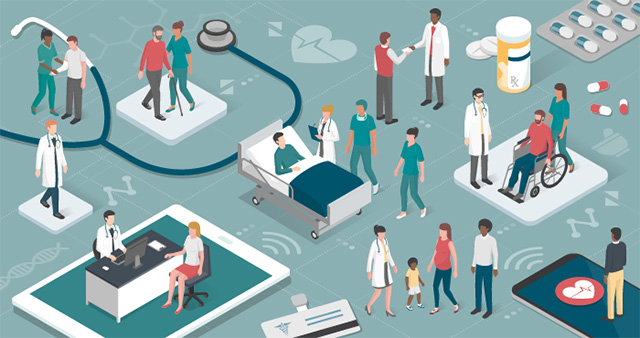When someone needs intensive care, a hospital is the right place for 24/7 support and monitoring by dedicated nurses and providers. But what if there is no local option? When hospitals close or reduce services, entire counties can lose access to ICUs, specialty services, and more. While transfers are sometimes necessary, there is an additional burden placed on patients and their families and caregivers who must travel far from home each day. So how can health systems and communities ensure these high acuity services remain accessible locally?
Vituity created a hub-and-spoke model for intensive care that uses a single, integrated provider team to provide a combination of onsite and tele-ICU care for critically ill patients across an entire region. Unlike a typical tele-ICU model with a remote command center, here a single team of intensivist physicians cared for patients in-person and remotely. This approach ensured patients had high acuity care close to home and offered hospitals the flexibility to meet local pandemic surges. Providers were able to deliver patient care– virtually or in-person – as facilities experienced different needs.
The Challenge: Maintaining Local, Cost-Effective Acute Care Services
The Southern Illinois Division of Hospital Sisters Health System (HSHS) includes a large hospital in the St. Louis suburbs as well as smaller hospitals in rural counties. The hospital had identified two key challenges:
- ICU volumes were too low to make full-time physician staffing at the smaller hospitals cost-effective.
- Quality performance measures (including sepsis) were low across all locations.
Vituity Solution: Integrating Acute Care Across Hospital Sites
To meet the critical care needs of the range of hospitals and communities, Vituity rolled out a hub-and -spoke model, where the services of the tertiary care hospital become a centralized resource across the region. The intensivist group became a single team, providing onsite and tele-ICU coverage across all four hospitals.
At the same time, thanks to our integrated approach, critical care, hospital medicine, and emergency medicine physicians worked together across hospitals. As a result:
- Intensivists were available for patient consults when needed regardless of location.
- Participating practices worked as a team. Together they created shared protocols, clinical pathways and developed quality and efficiency goals to improve effectiveness of the approach.
Results: Scalable Services, Improved Quality and Cost Savings
After implementation, the hospital system saw impressive and immediate results:
- Cost Reduction - 35% cost savings in critical care staffing by leveraging a single team of intensivists who could provide onsite and tele-ICU coverage.
- Better Outcomes - In less than a year, all four hospitals experienced dramatic improvements in quality. Hospitals collectively meet 85-92% sepsis-related benchmarks each month. Additionally, they experienced zero CLABSI infections in the first year of implementation, and critical care response times also dropped below expected benchmarks.
- Flexibility to Meet Demand - This model was lifesaving during the pandemic when ICU capacity was stretched. As an integrated care team, the intensivists, hospitalists, and emergency physicians were able to rapidly adapt and support the surge in critically ill patients. Because the care team was already fully comfortable with tele-ICU care and consults, the group of dedicated intensivists could effectively manage increased volumes.
All four hospitals in the HSHS Southern Illinois Division continue to offer local high acuity services, benefiting the patient and the community. As healthcare moves to meeting patients when, where, and how they need care, we believe this is the future of critical care.























